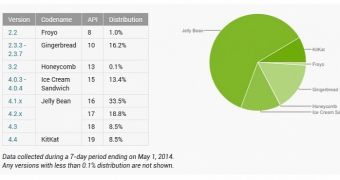The latest data on the Android platform distribution is now out, showing the KitKat has gained a lot of ground in the past month, now accounting for 8.5 percent of all active Android-based devices out there.
Last month, the platform release was loaded on 5.3 percent of all active devices out there, which means that it has grown over 50 percent in the time frame.
This was mainly due to the availability of more new handsets running under it, including the HTC One M8, Samsung Galaxy S5, and Sony Xperia Z2, the latest flagship phones from these leading makers.
Even so, Jelly Bean is still loaded on the largest number of Android smartphones and tablets out there, currently accounting for 60.8 percent of them.
The Android 4.1.x Jelly Bean platform release powers 33.5 percent of all devices, Android 4.2.x is loaded on 18.8 percent of them, while 4.3 Jelly Bean accounts for 8.5 percent of all active Android devices on the market today.
However, the chart does show that Android 4.0.3 – 4.0.4 Ice Cream Sandwich is still loaded on 13.4 percent of all devices, and that the 2.3.3 - 2.3.7 Gingerbread iteration of the OS is powering 16.2 percent of them.
Android 3.2 Honeycomb is still present on the chart, with 0.1 percent share, while Android 2.2 Froyo is slowly fading away with 1 percent share.
These numbers are based on data collected from the new Google Play Store app in the 7-day period prior to May 1, 2014. The app is available only for handsets running under Android 2.2 or up, and the results do not include platform releases older than that.
“Beginning in September, 2013, devices running versions older than Android 2.2 do not appear in this data because those devices do not support the new Google Play store app,” Google notes on the Android Developers website.
While newer Android platform releases are indeed taking over the distribution charts, it might still take a while before older iterations disappear entirely.
Google has been long criticized for the lack of unification on the platform, given the freedom that manufacturers had when it came to the loading of different OS flavors on new devices, but it seems that things are changing now.
Recently, the company has changed its licensing agreement to impose the use of the latest operating system versions on newer devices, and it seems that this is finally paying off.
With more Android 4.4 KitKat handsets expected to arrive on shelves in the coming months, and with manufacturers delivering updates for existing phones, we should see this platform version taking the lead on distribution charts sooner rather than later, so stay tuned.

 14 DAY TRIAL //
14 DAY TRIAL //